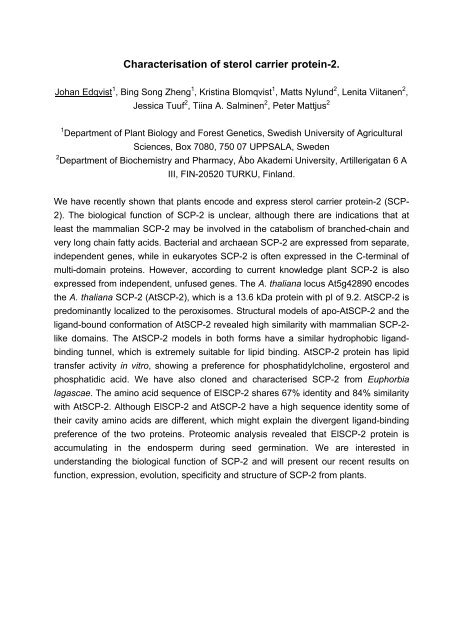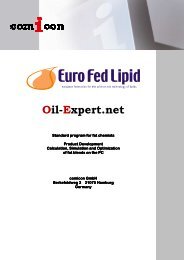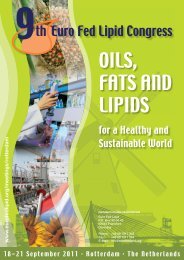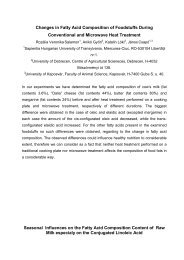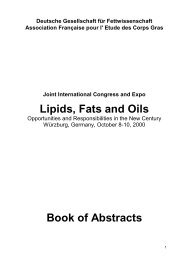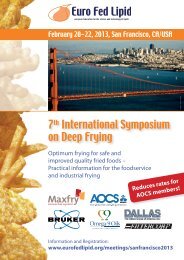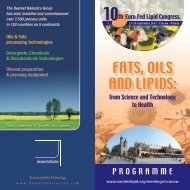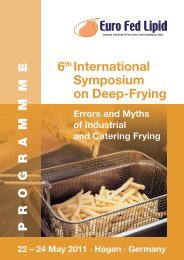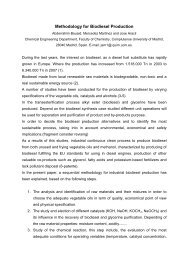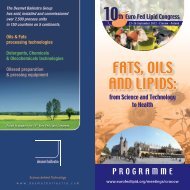Abstracts now available online - Euro Fed Lipid
Abstracts now available online - Euro Fed Lipid
Abstracts now available online - Euro Fed Lipid
You also want an ePaper? Increase the reach of your titles
YUMPU automatically turns print PDFs into web optimized ePapers that Google loves.
Characterisation of sterol carrier protein-2.<br />
Johan Edqvist 1 , Bing Song Zheng 1 , Kristina Blomqvist 1 , Matts Nylund 2 , Lenita Viitanen 2 ,<br />
Jessica Tuuf 2 , Tiina A. Salminen 2 , Peter Mattjus 2<br />
1<br />
Department of Plant Biology and Forest Genetics, Swedish University of Agricultural<br />
Sciences, Box 7080, 750 07 UPPSALA, Sweden<br />
2<br />
Department of Biochemistry and Pharmacy, Åbo Akademi University, Artillerigatan 6 A<br />
III, FIN-20520 TURKU, Finland.<br />
We have recently shown that plants encode and express sterol carrier protein-2 (SCP-<br />
2). The biological function of SCP-2 is unclear, although there are indications that at<br />
least the mammalian SCP-2 may be involved in the catabolism of branched-chain and<br />
very long chain fatty acids. Bacterial and archaean SCP-2 are expressed from separate,<br />
independent genes, while in eukaryotes SCP-2 is often expressed in the C-terminal of<br />
multi-domain proteins. However, according to current k<strong>now</strong>ledge plant SCP-2 is also<br />
expressed from independent, unfused genes. The A. thaliana locus At5g42890 encodes<br />
the A. thaliana SCP-2 (AtSCP-2), which is a 13.6 kDa protein with pI of 9.2. AtSCP-2 is<br />
predominantly localized to the peroxisomes. Structural models of apo-AtSCP-2 and the<br />
ligand-bound conformation of AtSCP-2 revealed high similarity with mammalian SCP-2like<br />
domains. The AtSCP-2 models in both forms have a similar hydrophobic ligandbinding<br />
tunnel, which is extremely suitable for lipid binding. AtSCP-2 protein has lipid<br />
transfer activity in vitro, showing a preference for phosphatidylcholine, ergosterol and<br />
phosphatidic acid. We have also cloned and characterised SCP-2 from Euphorbia<br />
lagascae. The amino acid sequence of ElSCP-2 shares 67% identity and 84% similarity<br />
with AtSCP-2. Although ElSCP-2 and AtSCP-2 have a high sequence identity some of<br />
their cavity amino acids are different, which might explain the divergent ligand-binding<br />
preference of the two proteins. Proteomic analysis revealed that ElSCP-2 protein is<br />
accumulating in the endosperm during seed germination. We are interested in<br />
understanding the biological function of SCP-2 and will present our recent results on<br />
function, expression, evolution, specificity and structure of SCP-2 from plants.


